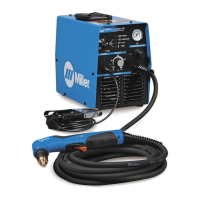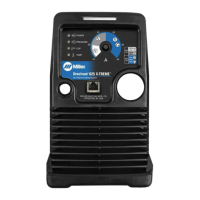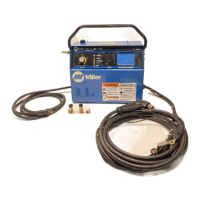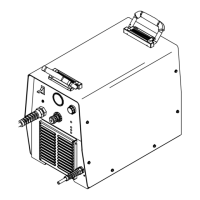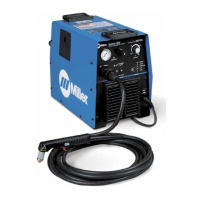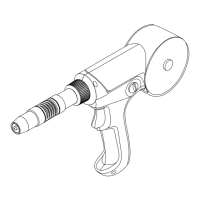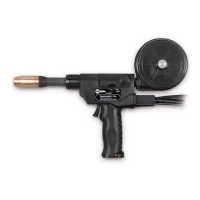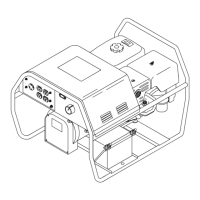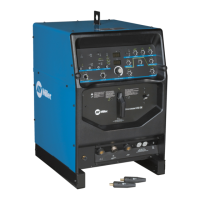How to extend the tip life on my Miller Welding System?
- AAllen ArroyoSep 3, 2025
To address short tip life on your Miller Welding System, check and clean the drag shield of any slag, particles, and debris. Also, check the input air pressure.
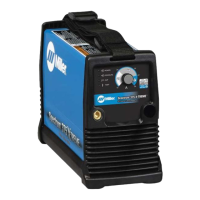
How to extend the tip life on my Miller Welding System?
To address short tip life on your Miller Welding System, check and clean the drag shield of any slag, particles, and debris. Also, check the input air pressure.
How to extend the short tip life on my Miller Spectrum 375 X-TREME?
To extend tip life, check and clean the drag shield of any slag, particles, and debris. Also, check the input air pressure.
How to troubleshoot no pilot arc on Miller Spectrum 375 X-TREME Welding System?
If you're experiencing difficulty establishing an arc or there's no pilot arc on your Miller Welding System, start by cleaning or replacing any worn consumables as needed. Also, check the torch and torch cable for any damage.
What does it mean when the pressure status light is on on my Miller Welding System?
If the Miller Welding System is showing the Pressure status light On, check for sufficient gas/air supply pressure. Also, check for a dirty air filter and replace it if necessary. Inspect the air lines for any leaks. If problems persist, have a Factory Authorized Service Agent check the pressure switch and control board.
Why sparks come out top of cut or cut is not clean with my Miller Spectrum 375 X-TREME?
If your Miller Welding System shows sparks coming out the top of the cut, or if the cut isn't clean, first reduce the travel speed. Then, clean or replace the torch consumables as necessary, and ensure the work clamp is securely attached to the workpiece. Check if the unit is capable of cutting metals thicker than its rating.
How to fix Miller Welding System when arc goes on and off while cutting?
If the arc goes on and off while cutting with your Miller Welding System, try increasing the travel speed. Also, clean or replace the torch consumables as needed and ensure the work clamp is securely attached to the workpiece.
What to do if Miller Spectrum 375 X-TREME Welding System pilot arc is working, but there is no cutting output?
If the pilot arc is working but there's no cutting output from your Miller Welding System, first ensure that the work clamp is properly connected. Additionally, clean or replace any worn consumables as necessary.
What to do if the arc goes out while cutting with my Miller Spectrum 375 X-TREME Welding System?
If the Miller Welding System's arc goes out while cutting, ensure the work clamp is securely attached to the workpiece. Also, make sure the tip is on or near the workpiece (approximately 1/16 in. to 1/8 in.). Clean or replace the torch consumables as needed.
Why is the temperature status light on my Miller Spectrum 375 X-TREME Welding System?
If the Temperature status light is on, it indicates that the Miller Welding System unit is overheating. Allow the fan to run to cool it down. The light should turn off once the unit has cooled sufficiently. If the problem persists, consult a Factory Authorized Service Agent to check the control board.
What to do if capacitor voltage does not drop to near zero after several minutes in Miller Spectrum 375 X-TREME?
If the capacitor voltage in your Miller Welding System doesn't drop to near zero after several minutes, use a bleeder resistor of between 200 and 500 ohms, at least 10 watts, and #16 AWG 600 volts AC insulation rated wire to discharge the capacitor(s).
| Input Voltage | 120/240 V |
|---|---|
| Input Phase | 1-Phase |
| Output Current | 30 A |
| Open-Circuit Voltage (OCV) | 240 VDC |
| Processes | Plasma Cutting |
| Weight | 19 lbs (8.6 kg) |
| Plasma Cutting Capacity | 3/8 in (9.5 mm) at 10 ipm (254 mm/min) |
| Gas Supply | Compressed Air |
| Gas Flow Rate | 4.5 cfm (127 L/min) |
| Gas Pressure | 70 psi (4.8 bar) |
Explains the meaning of various safety symbols used in the manual.
Details the specific dangers associated with plasma arc cutting processes.
Covers extra hazards during installation, operation, and maintenance.
States chemicals in the product known to cause cancer or birth defects.
Lists key safety standards and their sources for reference.
Discusses electromagnetic fields and their potential impact on medical implants.
Provides additional safety symbols found on CE products.
Explains various technical symbols and their meanings.
Identifies where to find unit serial and rating information.
Details the general specifications and operating temperature limits.
Provides physical dimensions of the cutting torch.
Provides physical dimensions of the power source unit.
Explains duty cycle limits and procedures for preventing overheating.
Outlines IP rating and temperature ranges for operation and storage.
Guidance on choosing a suitable location for the equipment.
Instructions for connecting the air supply to the unit.
Steps for connecting and disconnecting the work cable.
How to properly connect the work clamp to the workpiece.
Recommendations for electrical service requirements and safety.
How to select and connect the appropriate MVP plug.
Specific instructions for connecting 120V input power.
Specific instructions for connecting 240V input power.
Identifies and explains the unit's controls and indicators.
Provides recommended cutting speeds for various materials and thicknesses.
Outlines best practices for using the plasma cutting system.
Step-by-step guide for performing cutting operations.
Step-by-step guide for piercing operations.
Schedule and procedures for regular equipment maintenance.
Instructions for safely removing the unit's wrapper for access.
Procedures for inspecting and replacing the air filter element.
Guide for inspecting and replacing torch parts like tip and electrode.
Explains the meaning of status and trouble lights on the unit.
Provides solutions for common power source and torch issues.
